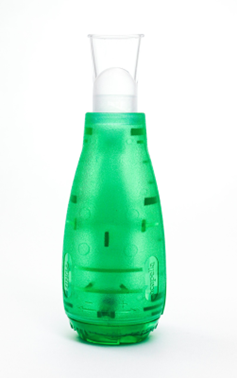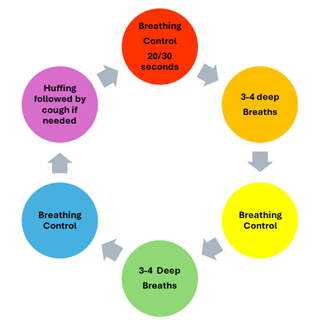2.1 Bronchial Hygiene
Bronchial hygiene, sometimes called airway clearance therapy (ACT) or pulmonary toilet, is a critical component of respiratory care aimed at maintaining a patent airway and ensuring effective ventilation and oxygenation. It involves a variety of techniques and interventions designed to remove mucus or secretions from the respiratory tract. Proper airway clearance is essential for patient care and plays a significant role in recovery from acute illnesses, particularly those affecting the respiratory system.
There are several techniques that a respiratory therapist can choose to use when treating patients with excess mucus or secretions.
Chest Physiotherapy (CPT): This involves postural drainage, manual percussion, and vibration of the chest to loosen secretions, making them easier to expectorate. This is also sometimes referred to as postural drainage percussion vibration (PDPV).
Positive Expiratory Pressure (PEP) Therapy: PEP uses devices that create resistance during exhalation, helping to keep the airways open and mobilize secretions.
High-Frequency Chest Wall Oscillation (HFCWO): High-frequency chest wall oscillation uses a mechanical vest that vibrates at high frequencies to help loosen and mobilize mucus.
Breathing and Cough Techniques: This involves coaching a patient to purposefully cough to aid in effective removal of secretions. These techniques include the huff cough or forced expiratory technique (FET), autogenic drainage, and quad cough.
Mechanical Insufflation Exsufflation (MIE) Therapy: This device delivers positive pressures of 30 to 50 cmH2O over a 1–3 second period and then the airway pressure is suddenly reversed to a negative pressure of -30 to -50 cmH2O. This helps patients with neuromuscular diseases generate expiratory flow rates to mobilize secretions.
Intrapulmonary Percussive Ventilation (IPV): This involves a series of small tidal volumes delivered at high-frequency pressurized bursts of gas cycles. The pulses of gas flow help break up secretions for mobilization.
Continuous Positive Expiratory Pressure/Continuous High-Frequency Oscillation (CPEP/CHFO): These devices involve two modes that provide hyperinflation for 2.5 minutes and continuous pulses of positive pressure for 2.5 minutes. These are repeated for a 10-minute therapy cycle.
Chest Physiotherapy[1]
This technique involves postural drainage, along with percussion and vibration, to facilitate secretion clearance.
Postural drainage involves positioning a person with the assistance of gravity to aid the normal airway clearance mechanism. Postural drainage positioning varies based on specific segments of the lungs with a large amount of secretions. Postural drainage is the drainage of secretions, by the effect of gravity, from one or more lung segments to the central airways (where they can be removed by a cough or mechanical aspiration). Each position consists of placing the target lung segment(s) superior to the carina. Positions should generally be held for 3–15 minutes. Standard positions are modified as the patient’s condition and tolerance warrant. Before determining the postural drainage position, it is very important to auscultate the lungs and identify the lung segments where added sound is heard.
View the following supplementary YouTube video[2] demonstrating the postural drainage positions and CPT: Postural Drainage Positions and Chest Physiotherapy (CPT)
Percussion is also referred to as cupping. The purpose of percussion is to intermittently apply kinetic energy to the chest wall and lungs. This is accomplished by rhythmically striking the thorax with a cupped hand or mechanical device directly over the lung segment(s) being drained.
Vibration involves the application of a fine tremorous action (manually performed by pressing in the direction that the ribs and soft tissue of the chest move during expiration) over the draining area. In this technique, a rapid vibratory impulse is transmitted through the chest wall from the flattened hands of the therapist by isometric alternate contraction of the forearm flexor and extensor muscles to loosen and dislodge the airway secretions.
View the following supplementary YouTube video[3] where percussion and vibration is demonstrated: Chest Physical Therapy (CPT) | Medical Definition (Explainer Video)
Vibratory Positive Expiratory Pressure[4]
Vibratory positive expiratory pressure (PEP) – sometimes called oscillatory PEP (OPEP) therapy – uses handheld devices such as flutter valves, Acapella (see Figure 5[5]), or Aerobika devices for patients who need assistance in clearing mucus from their airways. These devices require a prescription and are used in collaboration with a respiratory therapist or advanced health care provider. To use vibratory PEP therapy, the patient should sit up, take a deep breath, and blow into the device. A flutter valve within the device creates vibrations that help break up the mucus so the patient can cough and spit it out. Additionally, a small amount of positive end-expiratory pressure (PEEP) is created in the airways that helps to keep them open so that more air can be exhaled.

View the following supplementary YouTube video[6] where the proper use of the Aerobika is demonstrated: How to Use the Aerobika* Oscillating Positive Expiratory Pressure Therapy System
High-Frequency Chest Wall Oscillation
High-frequency chest wall oscillation (HFCWO) is an airway clearance technique in which external chest wall oscillations are applied to the chest using an inflatable vest that wraps around the chest. These machines produce vibrations at variable frequencies and intensities, helping to loosen and thin mucus and separate it from airway walls.
HFCWO involves an inflatable jacket that is attached to a pulse generator by hoses that mechanically enable the equipment to perform at variable frequencies (5–25 Hz). The generator sends air through the hose, which causes the vest to inflate and deflate rapidly. The vibrations not only separate mucus from the airway walls but also help move it up into the large airways. Typically, it is paused during the 20- to 30-minute HFCWO treatment every 5 minutes to cough out loosened mucus that has moved into the large airways.
View the following supplementary YouTube video[7] where a “vest” treatment is being performed: Giving a vest therapy treatment
Coughing Techniques and Deep Breathing
Active cycle of breathing technique is a technique performed by the patient and can be used to mobilize and clear excess pulmonary secretions and to generally improve lung function. It has a series of three main phases: breathing control, thoracic expansion, and forced expiratory technique (see Figure 6[8]).
Autogenic drainage is a diaphragmatic breathing pattern used by patients with respiratory illnesses (e.g., cystic fibrosis, bronchiectasis) to clear the lungs of mucus and other secretions. Various techniques are used, all of which combine positive reinforcement of deep breathing and voluntary cough suppression for as long as possible before evacuating the airways of mucus.

Coughing and deep breathing is a breathing technique similar to incentive spirometry but no device is required. The patient is encouraged to take deep, slow breaths and then exhale slowly. After each set of breaths, the patient should cough and attempt to expectorate secretions. This technique is repeated ten times every hour. Similar to an incentive spirometer, the purpose of coughing and deep breathing is to keep the airways open and clear of mucus to prevent atelectasis and pneumonia.[9]
The huff cough technique is helpful to teach patients who have difficulty coughing and expectorating mucus. Teach the patient to inhale with a medium-sized breath and then make a sound like “Ha” to push the air out quickly with the mouth slightly open. Huff cough is also called the forced expiratory technique (FET) and is best used to promote distal airways to remain open or prevent air trapping in obstructive diseases.
- Physiopedia. (2023). Respiratory physiotherapy. https://www.physio-pedia.com/index.php?title=Respiratory_Physiotherapy&oldid=334898 ↵
- NURSES- NOOK & CORNER. (2020, July 12). Postural Drainage Positions and Chest Physiotherapy (CPT) [Video]. YouTube. All rights reserved. https://www.youtube.com/watch?v=Rx2ADUgH_iw ↵
- Respiratory Therapy Zone. (2021, December 14). Chest physical therapy (CPT) | medical definition (explainer video) [Video]. YouTube. All rights reserved. https://www.youtube.com/watch?v=kg4wITMke08&t=75s ↵
- O’Hara-Leslie, E. K., Wade, A. C., & McLain, K. B. (2016). Foundations for assisting in home care. Open SUNY Textbooks. https://milnepublishing.geneseo.edu/home-health-aide/ ↵
- “Flutter Valve Breathing Device 3I3A0982.jpg” by Deanna Hoyord, Chippewa Valley Technical College is licensed under CC BY 4.0 ↵
- Trudell Medical International. (2013, June 13). How to Use the Aerobika* Oscillating Positive Expiratory Pressure Therapy System [Video]. YouTube. All rights reserved. https://www.youtube.com/watch?v=iy2oYadhF9Q ↵
- Pediatric Home Service. (2018, November 30). Giving a vest therapy treatment [Video]. YouTube. All rights reserved. www.youtube.com/embed/mKiix67dd90 ↵
- “Active Cycle of Breathing” by Kirsten Holbrook, Chippewa Valley Technical College is licensed under CC BY-NC 4.0 ↵
- Ernstmeyer, K., & Christman, E. (Eds.). (2024). Nursing fundamentals 2E. Open RN | WisTech Open. https://wtcs.pressbooks.pub/nursingfundamentals/ ↵

